INTRODUCTION
In 2015, the Museum of London installed a temporary exhibition called ‘Written in Bone’ to share the results of recent collaborative projects with its audience and community stakeholders. Its purpose was to investigate the settlement of Londinium Footnote 1 through the lives of four Londoners by examining where they had grown up and to establish aspects of their physical appearance and health using a variety of scientific methods. As the project was funded by the Museum's donors and collaborative research partners, the isotope and aDNA analyses were focused on these questions rather than full genome sequencing as other studies have done for Romano-British populations in Britain.Footnote 2
The Museum also used this opportunity to re-examine the funerary contexts and associated material culture of two males and two females in order to obtain a more nuanced and detailed insight into these objects and the role that they may have played in identity construction and expression.Footnote 3 This article presents the details of this project and evaluates the utility of this approach for our understanding of Romano-British identities and for public engagement.
MATERIALS AND METHODS
OSTEOLOGICAL ANALYSES
The four individuals selected for the exhibition were excavated from London (fig. 1) between 1979 and 2003 and are curated by the Centre for Human Bioarchaeology (Table 1). The human remains were recorded by Redfern between 2008 and 2014 using the Wellcome Osteology Research Database and the Museum of London methods.Footnote 4 The age and sex of each individual were established using the standard osteological methods for assessing the morphological features of the skull and pelvis.Footnote 5 Additionally, in order to further refine the age-estimations of the individual from Harper Road,Footnote 6 the auricular ageing method devised by Buckberry and ChamberlainFootnote 7 was applied, while the sex of the adolescent from Lant Street (LTU03 sk 385) was estimated using the methods employed by Shapland and Lewis.Footnote 8 The evidence for health and disease was recorded using the Museum of London methods,Footnote 9 supported by in-house digital and film radiography of pathological bones. Ancestry was assessed using macromorphoscopics, rather than a metric-based approach,Footnote 10 because the majority of the remains were fragmentary. This approach relies on the visual scoring of 16 cranial morphological features, the majority of which are found in the facial bones, with emphasis placed on the nasal area.Footnote 11
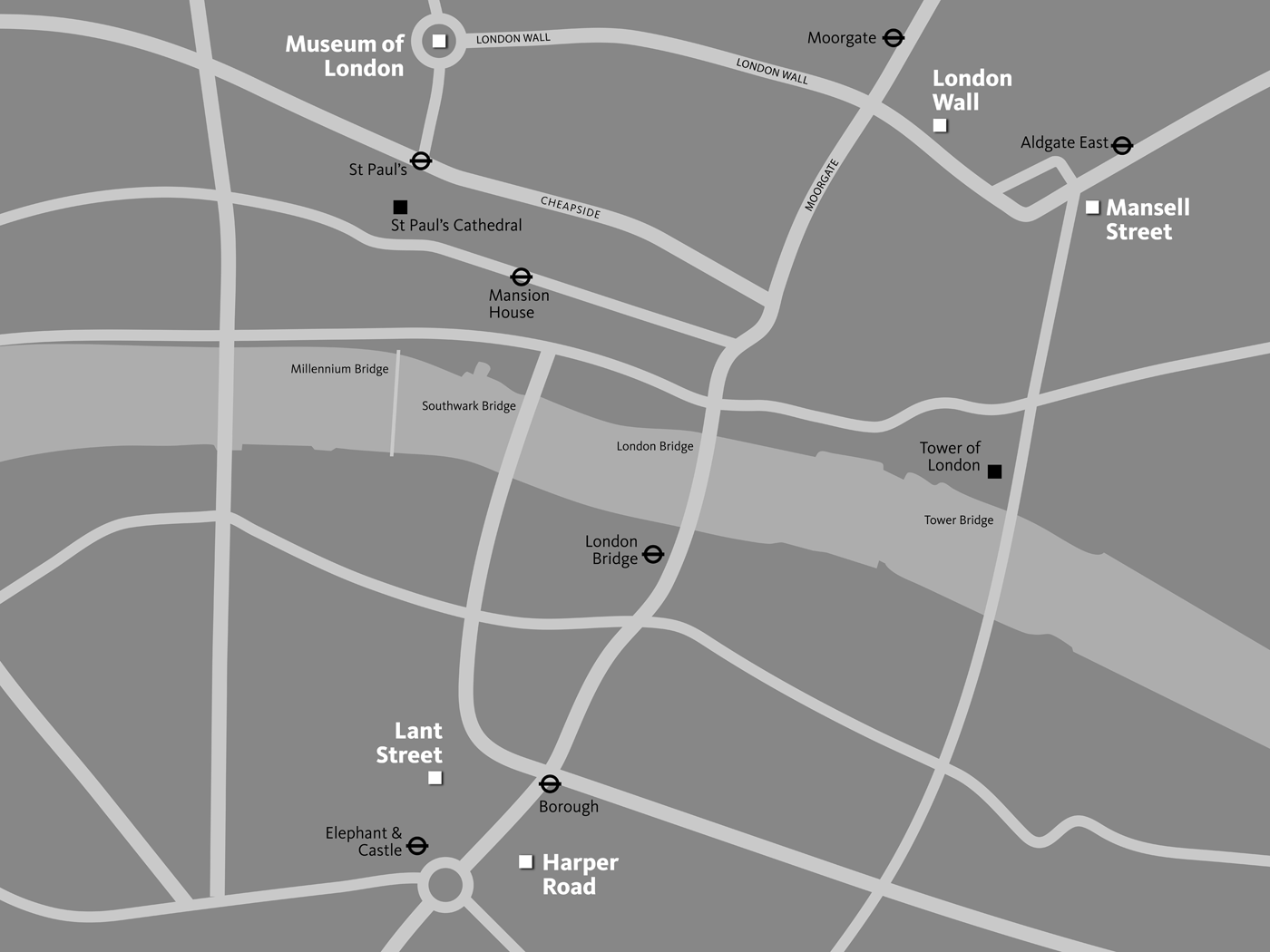
FIG. 1. Map showing the location of the sites in Roman London. (© Museum of London)
TABLE 1. SUMMARY INFORMATION FOR INDIVIDUALS IN THIS STUDY
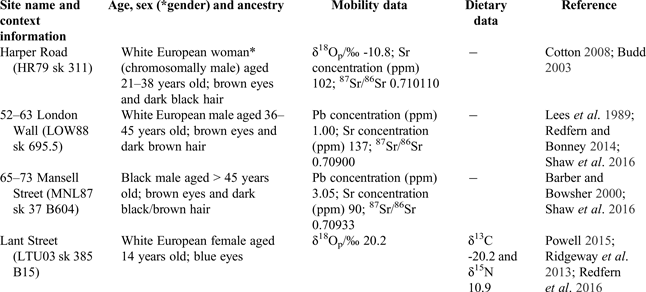
ANCIENT DNA ANALYSIS
A molar tooth from each of the individuals was selected for ancient DNA analysis (aDNA), with the aim of determining the possible presence of bacterial, fungal and viral pathogens, identifying hair and eye colour, establishing sex using chromosomal markers and investigating maternal ancestry (mtDNA) based on complete mitochondrial genomes. A detailed description of the methods employed is published on the Museum's website,Footnote 12 with only a brief overview being provided here.
All the subsampling and labwork was performed at the McMaster Ancient DNA Centre.Footnote 13 The human mitrochondrial bait set chosen for this project had previously been designed using Human mitochondrial rCRS GenBank Accession number J01415.2, which suggests possible localities of the haplogroups c. 500 years ago, prior to the era of intercontinental travel. Hair and eye colour was identified using a modified version of the HIrisPlex SNP assay designed for targeted enrichment in the ancient DNA lab.Footnote 14 The sex chromosome typing baits targeted three Y chromosome-specific genes (AMELY, SRY and TSPY) and two X chromosome-specific genes (AMELX, SOXL3). Gene sequences and NCBI genbank annotations for the five sex-linked genes were downloaded from RefSeq and targeted regions were obtained from previously published loci.Footnote 15 The presence of viral (e.g. smallpox) and bacterial (e.g. plague, tuberculosis) diseases was determined using a modified version of an array-based method for the detection of pathogens in ancient remainsFootnote 16 and the methods described by Marciniak.Footnote 17
STABLE-ISOTOPE ANALYSIS OF DIET AND MOBILITY
The stable-isotope analysis was undertaken during the course of three separate studies over the past 15 years, with different isotopes used to investigate diet and mobility in these individuals.Footnote 18 As the isotope study of the Harper Road woman had been undertaken some years ago and because the Museum was reluctant to undertake further destructive analysis on her last remaining tooth, the original mobility dataFootnote 19 were re-interpreted by Montgomery.Footnote 20
Analysis of childhood residency was undertaken using oxygen (δ18O), strontium (δ 87Sr/86Sr) and lead (δ207Pb/206Pb and 208Pb/206Pb) isotopes extracted from the dental enamel, with dietary isotopes of carbon (δ13C) and nitrogen (δ15N) extracted from rib bone samples for the individual from Lant Street.Footnote 21 The methods used to establish the local/non-local origin of the Harper Road individual are described in Budd,Footnote 22 the London Wall and Mansell Street burials by Shaw and colleagues,Footnote 23 and the Lant Street adolescent by Redfern and colleagues.Footnote 24
RESULTS
HARPER ROAD (HR79 sk 311)
This burial is one of the earliest from Londinium, dating from a.d. 50–70. It was located in Southwark (fig. 1) and excavated in 1979 as part of student training by the Southwark and Lambeth Archaeological Excavation Committee.Footnote 25 The grave was aligned on a north-east/south-west axis and the cut was c. 2.3 m long by 1.0 m wide. The skeleton had been placed on one side, in an extended position, with the skull orientated to the south-west; nails of various sizes (including one 101 mm in length) recovered from the grave fill may indicate the presence of a coffin.Footnote 26 The burial was also accompanied by several objects usually associated with a ‘female’ gender, some deemed ‘indigenous’ and others ‘Roman’, which are discussed below.
Bioarchaeological analysis revealed that the skeleton was an adult aged c. 21–38 years old, whose skull and pelvic morphology were determined to be female.Footnote 27 Unexpectedly, aDNA analysis identified male chromosomes (XY), with the expected number of reads for a genetic male in the X-chromosome regions (AMELX and SOX3) and Y-chromosome regions (SRY, TSPY, AMELY). This result does not mean that the bioarchaeological or aDNA data are incorrect; rather it suggests that this individual likely had a sex development disorder. Today, the incidence of such disorders is 1:4,000 to 1:5,000 live births, the signs of which can either present at birth or develop during childhood and adolescence.Footnote 28 We do not enter into speculation about this person's physical appearance, as the specific disorder could not be established and it was not possible to explore this further with aDNA due to limited resources for the current project. What is clear is that this individual was identified as a woman by her community,Footnote 29 a decision that we continue here and at the Museum in her display and gallery interpretation.Footnote 30
Unfortunately, none of the long bones were complete enough to estimate stature. The assessment of ancestry suggested that she was White European, while the HirisPlex test found that she had brown eyes and dark black hair. Her maternal haplotype was determined to be H2a2a1 whose geographic distribution (c. 500 years ago) covers eastern Europe, the Caucasus and Central Asia.Footnote 31 A re-evaluation of the stable isotope evidence for mobility suggested that in all likelihood she grew up in Britain.
The evidence for disease was limited to some degeneration in the joints, commonly observed in archaeological populations: a rotator cuff injury on the lesser tubercle of the left humerus, caused by a fall or else through over-use of the shoulder-joint, and degenerative changes to one cervical and one lumbar vertebra.Footnote 32 Only nine dental positions and three teeth were observable, but only one dental position had evidence for disease — periodontitis, a common infection of the gums.Footnote 33 No aDNA evidence for bacterial or viral diseases was found.
Her burial includes an important group of grave goods which have been the subject of a careful assessment by Cotton and this is expanded upon here (fig. 2).Footnote 34 A group of Claudio-Neronian pottery reflects access to imported vessels and perhaps the adoption of continental styles of dining. As Bird, Hall and Cotton suggest, some vessels may also have been carefully selected for inclusion in the burial because they were stamped with the potter's name Vitalis, perhaps a play on the words for life and vitality, which would indicate literate mourners with a relatively sophisticated knowledge of Latin.Footnote 35 A rectangular mirror placed at her feet implies the deliberate construction of identity through grooming and, as examples from Iron Age and Roman burials tend to be associated with females, this object also has gendered connotations.Footnote 36 Grooming practices may have been very visible symbols of personal cultural preferences in this early period, as some, such as arrangement of the hair using hairpins, were new introductions to Britain from the Continent,Footnote 37 while others, such as the preparation of cosmetics in two-piece copper-alloy sets, had a strong local Iron Age pedigree.Footnote 38 But while the mirror is a Roman type, it provides no real hint as to whether Harper Street woman used it according to indigenous practices or in a more ‘Romanised’ manner.Footnote 39

FIG. 2. Superior view of the reconstructed burial from Harper Road (HR79 sk 311). (© Museum of London)
The single most distinctive object is the bronze penannular neck ring/torc (fig. 3), which was broken and placed near to the mirror. The torc was rectangular sectioned with squared terminals and decorated with a ring-and-dot pattern on the hoop and feather motifs and transverse hatched bands at the terminals.Footnote 40 Cotton has argued that it was a ‘pidgin’ object, a ‘single creative response to a particular situation at the very beginning of Roman contact’.Footnote 41 While the find remains unique, we can now better situate it through comparison with two other classes of personal ornament, with which it would seem to be closely related. The first is a contemporary group of penannular strip armlets whose form and decorative vocabulary are closely related to the torc. These are distributed in south-eastern Britain, including London, but are particularly focused around Hertfordshire and East Anglia in the territory of the Trinovantes and the Catuvellauni.Footnote 42 The second type is represented by several copper-alloy penannular torcs of slightly different form, recently excavated from Baldock (Herts.) by the Heritage Network and awaiting publication, which have similar ‘feathered’ motifs on the terminals.Footnote 43
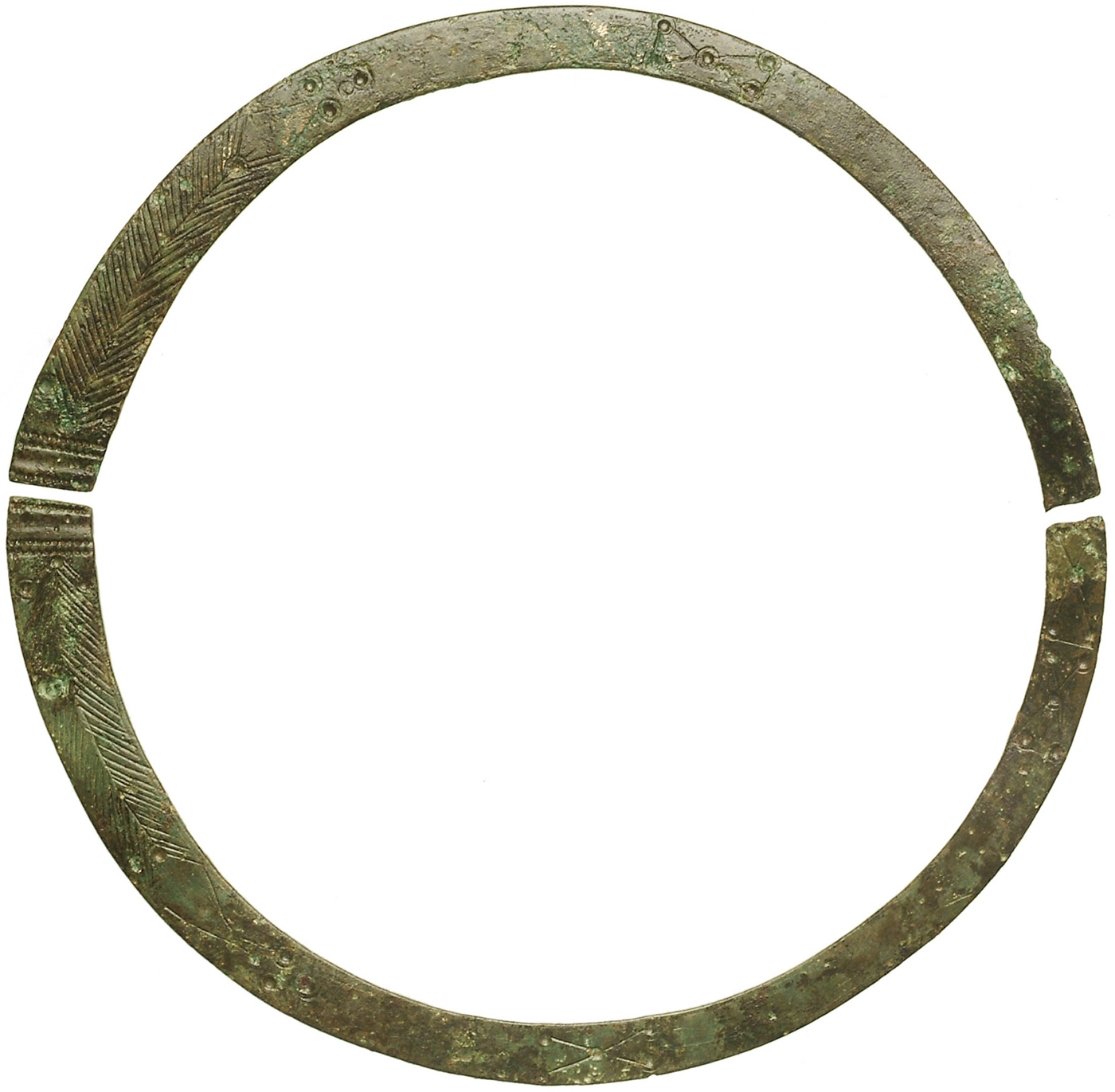
FIG. 3. The torc from the Harper Road burial. (© Museum of London)
The Harper Road torc can, therefore, be seen to be closely associated with a regionally distinct group of objects focusing on body care and decoration, although its precise significance remains ambiguous. Similarly regionalised dress traditions were arising across Britain at this time and several include new styles of torc/neck ring, often alongside the prominent use of Celtic art, which may perhaps indicate a stress on local identities in response to the Roman conquest.Footnote 44 The South-East has largely been excluded from such discussions, but it is possible that this group of material represents a comparable phenomenon, although the relatively short-lived nature of this group and the character of the decoration which eschews the same prominent use of insular La Tène art is rather different. This may relate to the specific local social context, particularly the speed of the initial conquest in the South-East and the huge influx of ‘Roman’ material culture, well represented in the Harper Road burial, which offered alternative sources of inspiration and competing avenues for the expression of power and prestige.Footnote 45 In fact some of the decoration could be seen as continental in inspiration; indeed Crummy has made a strong case that, while the armlets are a Romano-British regional phenomenon, they may have actually been armillae worn by Roman soldiers, battle honours from early campaigns in Britain, on the basis of the distribution and decoration, which includes cross-cut bands that could be interpreted as wreath motifs perhaps with connotations of victory.Footnote 46 Interestingly, the decorative emphasis of the Harper Road find is slightly different, with the wreaths all but absent. The feather or perhaps palm motifs found on some of the bracelets are enlarged and elaborated, more closely matching the Baldock torc. Cotton has gone as far as to suggest that these represent peacock feathers, which in a Classical tradition have connotations of immortality, apposite in a funeral context, as well as connections to the goddess Juno, protector of women.Footnote 47
We are left with two related interpretative possibilities. The first is a torc that belongs to a continentally influenced local dress tradition, which may in turn have influenced the design of British armillae found in the area. The second is a torc closely related to the local Baldock finds but which also draws upon Classical imagery and the specific provincial aesthetic model of the armillae worn by the Roman soldiers and veterans who would have been frequently encountered in places like Londinium. Such imitation may be taken as an acknowledgement of the power of these individuals, but if transformed into a ‘native’ torc worn by a woman and arguably with ‘feminised’ peacock iconography could alternatively be seen as a powerful subversion of male military symbolism.Footnote 48
In light of these findings, we support Cotton's assertion that this woman's burial is a response by indigenous communities to the rapidly changing world of first-century south-east Britain.Footnote 49 The richness of the burial and the objects included within support the evidence for female power and agency in late Iron Age societies and hint at her status and role within her community. During periods of colonisation it is women, more so than men, who act as crucial intermediaries between cultures.Footnote 50
52–63 LONDON WALL (LOW88 sk 695.5)
This individual was recovered from a pit in association with other disarticulated human bones from an industrial and domestic site in the Walbrook valley, close to the Walbrook stream and dates to a.d. 125–200 (fig. 1).Footnote 51 During this time, this part of London was an important industrial area for the manufacture of glass, metal-, wood-, leather- and bone-working and a dumping area for waste. However, in the upper part of the valley (outside the settlement's walls), it was an important ritual space used as a cemetery and for the deposition of votive offerings.Footnote 52 The site was located within the Roman city walls, hence the evidence of clay-and-timber buildings and a gravel road, as well as amphorae, glassware, a wooden bowl and utensil, bone hairpins, an ivory bracelet, decorative copper-alloy mounts, many shoes (e.g. a soft one-piece moccasin), copper-alloy coins and a writing implement.Footnote 53 The cranium was recovered from an oval-shaped pit which was 3.40 by 2 m and 0.50 m deep, suggesting that it was not dug as a waste pit. It was filled with silt and contained a minimum number of ten adult male crania (no mandibles were recovered) and one adult right femoral shaft. These crania had evidence for extensive and lethal peri- and ante-mortem blunt and sharp-force injuries and have been interpreted as victims of ritualised and structural violence, either as headhunted victims of the Roman army, executed prisoners or defeated gladiators.Footnote 54
Bioarchaeological analysis determined that the cranium was of a male (this time supported by the chromosome results XY), aged 36–45 years old. Assessment of ancestry determined that he was White European, while the HirisPlex test found that he had brown eyes and dark black hair. His maternal haplotype was J1b1a1, which has a very wide distribution (c. 500 years ago) across Europe, North Africa, the Near East and the Caucasus.Footnote 55 The mobility isotope results were sadly inconclusive for this individual. He has a low lead concentration (1 ppm) that places him on the edge of the anthropogenic English lead ore field, but too close to the culturally defined parameters for Roman Britain to exclude him definitely from being British, while his strontium result falls within the London region, though these values are also found in many parts of Europe.Footnote 56
He had poor dental health, as calculus, carious lesions and periodontal disease were observed; the latter was also identified using aDNA, as Tannerella forsythia, Treponema denticola, Porphymonas gingivalis and Fusobacterium nucleatum were present. These dental diseases are frequently encountered in Romano-British and Roman urban populations.Footnote 57 He also experienced episodes of compromised health during childhood, as his dentition had evidence for enamel hypoplastic defects, while healed cribra orbitalia and porotic hyperostosis were present to several of his cranial bones. These diseases have multifactorial origins, including periods of ill health, anaemia, a heavy parasite load and compromised nutrition.Footnote 58 Environmental and other bioarchaeological data from Britain attest to the presence of parasites and the frequent occurrence of these diseases in both rural and urban populations.Footnote 59
The majority of observed pathology related to violent injuries, including a healed fracture to his left zygomatic bone, an injury typically produced during assaults.Footnote 60 Dental chipping is also present, which has a multifactorial origin but can be caused by blows to the face.Footnote 61 Most of the injuries to his cranium were sustained shortly before or at the time of death, with multiple blunt-force fractures observed to the facial area and right temporal bone, attesting to the individual having sustained numerous direct blows to the faceFootnote 62 (fig. 4).
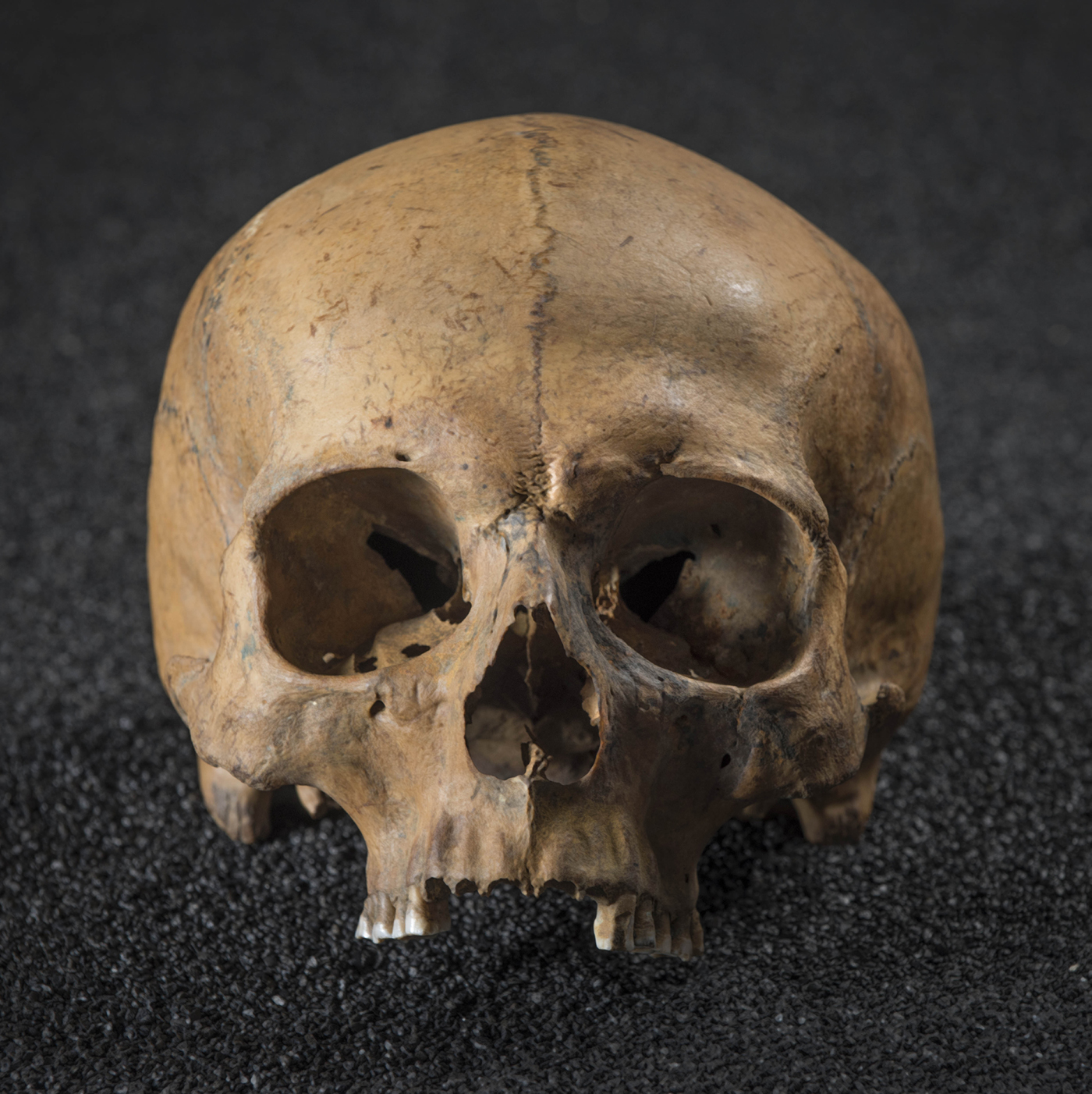
FIG. 4. Anterior view of the male cranium (LOW88 sk 695.5) showing evidence for dental chipping and injuries to the facial cranial bones. (© Museum of London)
Peri-mortem injuries of this nature are not observed in the normative cemetery populations of Londinium. Although many males have healed fractures produced by inter-personal violence such as nasal bone fractures, there is not the same evidence for this degree of ‘over-kill’ in the other individuals.Footnote 63 This reinforces the atypical and unusual injury pattern and types of violence observed at London Wall. There was no taphonomic evidence from this cranium or others in the same context to suggest that the remains had been carried to the site by water-action.Footnote 64 Therefore, it is most likely that along with the partial remains of nine other men, his cranium had been collected from elsewhere in the settlement and deposited in a specially dug pit in the Walbrook valley. The inconclusive stable-isotope results mean that unfortunately we are unable to clarify the possible reason for his death (i.e. trophy head).
65–73 MANSELL STREET (MNL87 sk 37 B604)
This burial was part of the ‘Eastern’ burial ground of Londinium, located to the south of a spur-road off the main road from the settlement which leads to Colchester (fig. 1).Footnote 65 The area is divided into two plots, defined by the presence of the road and two ditches (one east–west, the other north–south) that show evidence for maintenance, being redug and cleaned on several occasions, supporting the suggestion that the burial grounds along this important road were formally managed.Footnote 66 The burial plots were in use between the second and fourth centuries, with this burial being assigned a date of a.d. 180–400.Footnote 67 The burial had been heavily truncated in later periods by the digging of a gravel pit and concrete foundations. The individual had been laid out in a supine position with the head orientated to the west; no extant grave goods were observed, though it is possible that existing goods were destroyed during these periods of disturbance.Footnote 68
The damage to the grave meant that the human remains were limited to a highly fragmentary axial skeleton (skull, thorax, spine and pelvis) (fig. 5). Analysis estimated this individual to be a male (supported by the genetic results), aged over 45 years old, who had Black ancestry, while the HirisPlex analysis found that he had brown eyes and dark black/brown hair. His maternal haplotype was V16, which is evenly distributed across Europe and North Africa (c. 500 years ago), with the stable-isotope results showing that he had spent his childhood in the London region.Footnote 69 The presence of people born in London with African ancestry is not an unusual or atypical result for Londinium, as a multidisciplinary study of a southern cemetery has found,Footnote 70 nor for other urban centres in Britain, as with the female known as the ‘Ivory bangle Lady’ from Eboracum (York).Footnote 71
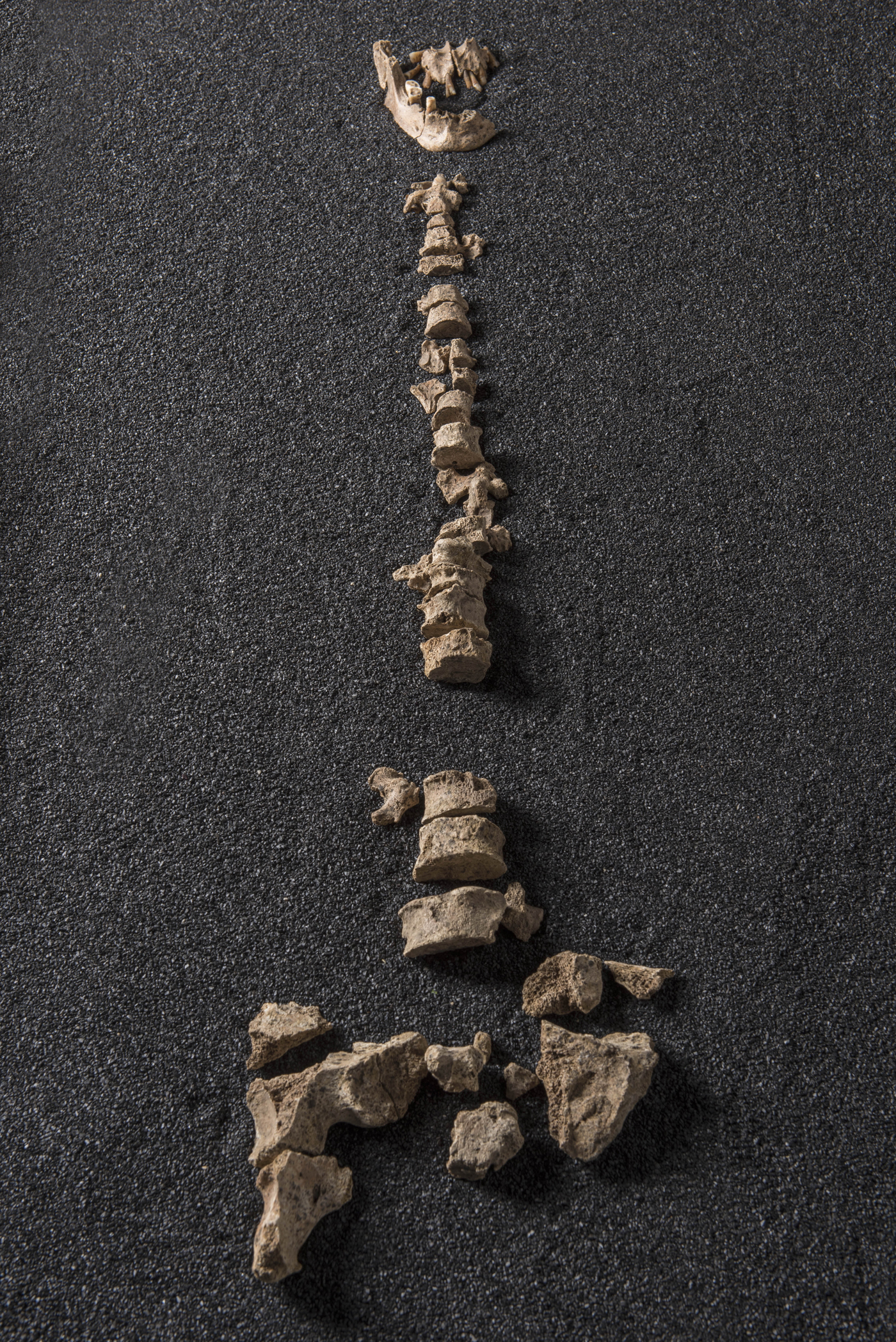
FIG. 5. Skeleton of the adult male (MNL87 sk 37 B604) from Mansell Street. (© Museum of London)
The fragmentary and truncated nature of this male's skeleton meant that some health indicators such as cribra orbitalia were not observable, because the roofs of the eye sockets were not present. Examination of the extant dentition showed that he suffered from calculus, carious lesions and associated periapical abscesses but also periodontal disease, which was also attested in the aDNA results that detected the presence of Tannerella forsythia, Treponema denticola and porphyromonas gingivalis. As above, these are frequently observed diseases in Romano-British populations.
The male also suffered from osteoarthritic conditions of the spine, as degenerative changes were observed to the cervical, thoracic and lumbar vertebrae; also present from the 7th to 11th thoracic vertebrae (mid to lower chest area) was Diffuse Idiopathic Skeletal Hyperostosis (DISH) (fig. 5), a condition which causes ossification of the ligaments, particularly the spinal column, and is related to age.Footnote 72 Previous palaeopathological studies suggested a link between DISH and a rich diet/obesity, but these have been rejected in light of more recent research and clinical findings that have identified low serum levels of the natural osteogenesis (bone formation) inhibitor Dickkopf-1 (DKK-1) in sufferers of this disease. Much of the earlier data regarding the co-existence of DISH, diabetes and obesity were derived from North American populations.Footnote 73 The fusion of multiple vertebrae would not have been particularly debilitating, but he is likely to have experienced stiffness to his back.Footnote 74
His health and mobility were further compromised by the presence of Paget's disease in the 9th to 12th thoracic vertebrae, the pelvis and right portion of the mandible (fig. 5).Footnote 75 This disease causes bone deformity, because the balance of bone remodelling is affected, whereby bone tissue is destroyed in specific areas (e.g. pelvis, spine and skull), followed by a period of abnormal bone formation, creating bone which is weaker. The sufferer may be asymptomatic, or experience bone pain, joint stiffness, have warm skin over the affected bones and skull enlargement and deformities.Footnote 76 Interestingly, clinical research by Morales and colleaguesFootnote 77 found that sufferers of Paget's were more likely than a control group to have DISH, suggesting that there may be a genetic mechanism which makes Paget's disease sufferers more susceptible to developing DISH. Regrettably, these two diseases could not be explored at a genetic level in this male.
Our research has been able to establish certain aspects of this man's physical appearance and compromised mobility as contributing to aspects of his identity and life experience. At present, he is the only individual from Londinium to present with both DISH and Paget's disease and the only male to be diagnosed with Paget's disease.Footnote 78 However, the disturbed and truncated nature of his burial context prevents us from exploring social aspects of his identity, such as status.Footnote 79 The extant information suggests that he is typical of the many hundreds of Roman burials from Londinium.
52–56 LANT STREET (LTU03 sk 385, B15)
The burial was located in a cemetery in the southern settlement of Londinium, Southwark, and was excavated by Pre-Construct Archaeology in 2003 (fig. 1). This cemetery area was first established in the late first to second centuries. Following a hiatus in the burial record, burial begins again at the site in the mid-third century and extends into the early fifth century.Footnote 80 The site developed into a large managed cemetery, with the richest burial belonging to this person;Footnote 81 the original publication assigned the burial to the fourth-century phase of activity on the site, although the dating of the grave goods may support a slightly earlier, third-century date.Footnote 82
The bioarchaeological analysis of the skeleton revealed a 14-year-old girl, a result supported by the chromosomal results XX. Her ancestry was determined to be White European, while the maternal haplotype was HV6, which (c. 500 years ago) is found in southern and eastern Europe, west Asia and north-east Africa. The HirisPlex test could only identify her eye colour with certainty, which was blue. Initially, it was suggested that she originated from North Africa,Footnote 83 but a revised interpretation of her stable-isotope results for mobility found that she had spent her younger childhood in the southern Mediterranean.Footnote 84 Dietary isotopes taken from rib bone (Table 1) indicated that she had been consuming terrestrial and marine resources local to the area. Bone turnover rates for the rib were estimated as an average of five years, meaning that she had lived in Londinium at least since the age of nine.Footnote 85
Her dentition revealed very poor dental health, as multiple dental caries were present, as well as calculus and periodontal disease — Tannerella forsythia, Treponema denticola and Fusobacterium nucleatum were detected using aDNA techniques. Several of the large carious lesions affected the first mandibular molars whose crowns were also severely affected by enamel hypoplastic defects. The thin and defective enamel in these teeth would have increased her risk of forming caries, because the crown would have been more vulnerable to decay.Footnote 86 The enamel hypoplastic defects were more severe than observed in other subadults from Londinium, with lines of exposed dentine observable to the naked-eye, most notably to the right maxillary first incisor, which also had a talon cusp present. This is a very rare non-metric dental trait and is characterised by a large, additional, projecting cusp on the lingual aspect of the tooth.Footnote 87 It is more frequently observed in females, with the maxillary incisors most commonly involved.Footnote 88 Other minor congenital conditions were observed in her skeleton, including an extra vertebra and partial union of some of her foot bones.Footnote 89 These conditions have a hereditary component but can also be caused by minor environmental disruptions during embryogenesis;Footnote 90 only the changes to the foot bones are likely to have impacted mobility, as this will have caused minor restriction to movement, though this may not have been detectable in everyday life.Footnote 91
Evidence for remodelling new bone was also observed to the legs, particularly the medial aspect of the tibiae (lower leg). This is a non-specific reaction to an unknown disease process, but the remodelling nature of the bone suggests that she was recovering from this health condition.Footnote 92 The radii and ulnae bones of the forearms display very mild anterior-posterior and lateral plastic bowing, while the shafts of the femora also show mild anterior-posterior bowing; no evidence for healed injuries was observed radiographically. This represents a remodelled case of mild ricketsFootnote 93 and, given that the changes are limited to the forearms and thigh bones, it is likely that she developed this metabolic disease when she was a crawling baby. Rickets was a disease recognised by Roman medical writers, who noted that toddlers in the city of Rome frequently developed the disease, but because the cause was unknown (see Rohnbogner's contribution above), they thought that it was caused by poor maternal/carer behaviour.Footnote 94 It is possible that a contributing factor was the use of swaddling for pre-mobile infants, a recommended childcare practice, as well as sun-avoidance practices, or covering of the skin by high-status females and mothers, which could then result in deficiency in the infant.Footnote 95
The girl's body was placed on a bed of chalk-like material in an extended position, with her arms by her side and her head orientated to the north-west.Footnote 96 Five grave goods were found. A glass aryballos (oil flask) was placed to the left of her head and an amphorisk flask to the right. A wooden casket with copper-alloy fittings and carved bone inlays (fig. 6), one of which depicted a female figure, was placed below the feet, and a clasp knife whose ivory handle was carved to depict a leopard holding meat or prey in its forepaws (fig. 7); the knife also had an 18-link copper-alloy chain. Nearby was a trilobate pierced handle copper-alloy key — they may have been attached but radiography was unable to determine whether this was true (fig. 6).Footnote 97
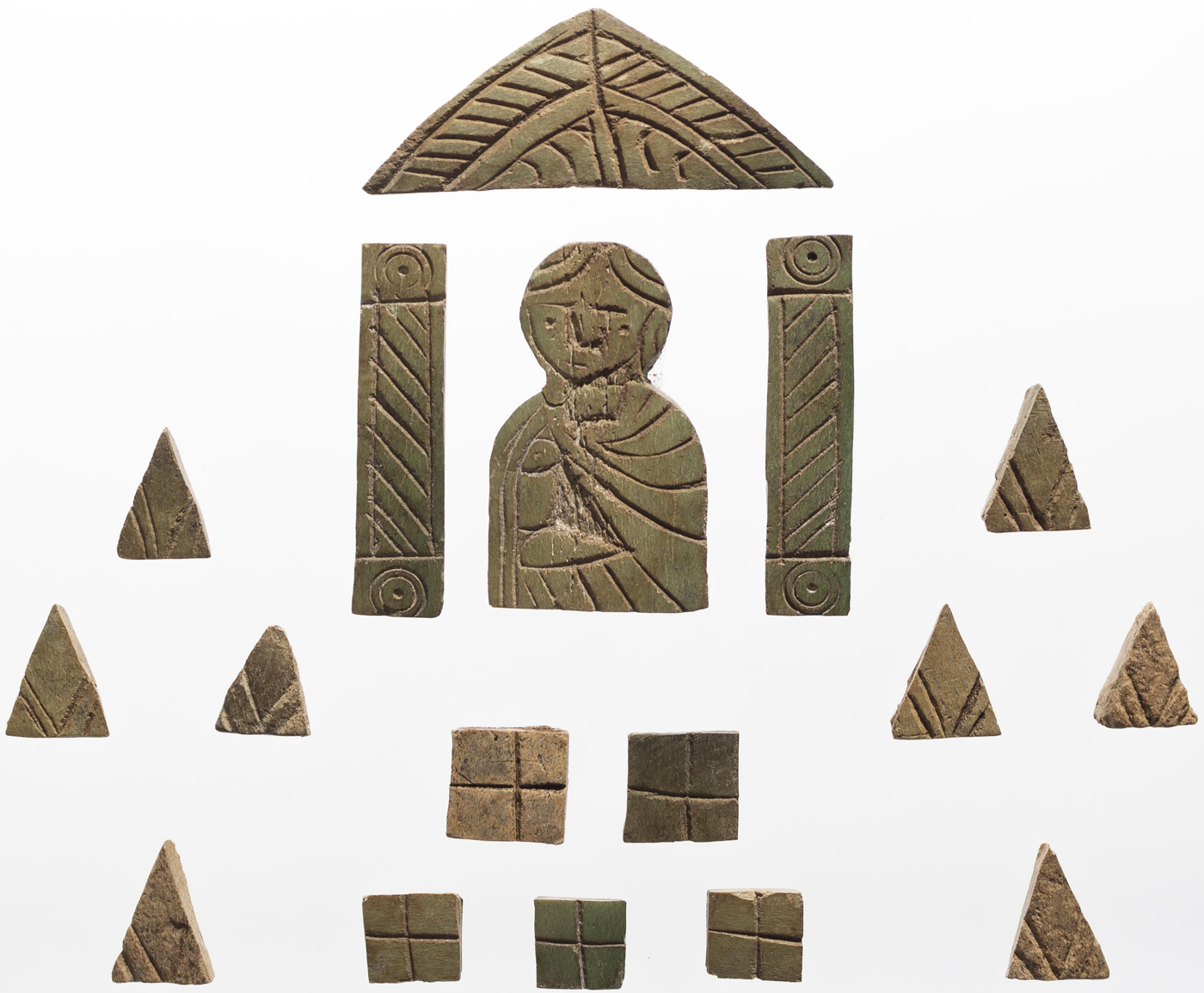
FIG. 6. Bone inlays from the wooden casket buried with LTU03 sk 385, B15. (© Pre-Construct Archaeology)
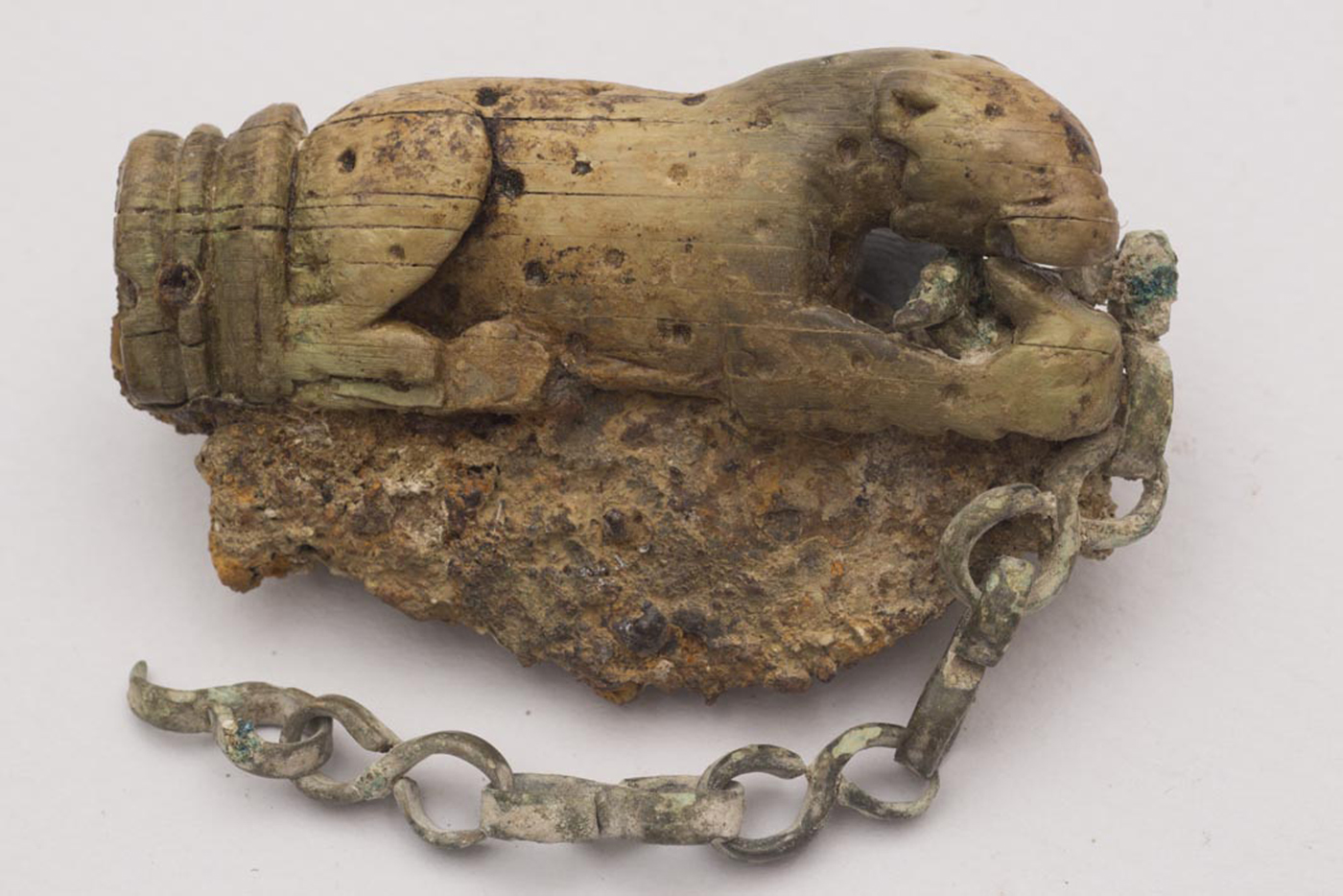
FIG. 7. Ivory leopard clasp knife buried with LTU03 sk 385, B15. (© Pre-Construct Archaeology)
The ivory leopard clasp knife handle is a rare findFootnote 98 and both the quality and the material suggest that it would have been an expensive and prized possession. Such knives were probably general purpose ‘pocket knives’ carried on the person. That it was possibly chained together with a small key, perhaps for a jewellery box or similar, may lend some support to this interpretation as a private objectFootnote 99 and it is possible that the fierce creature was also envisaged as a guardian of such a box and its contents.Footnote 100 It is not clear if this key fits the casket, as no lock was identified and the metal fittings were poorly preserved.Footnote 101 This is a box of some quality with figurative bone inlay depicting a female bust. No close parallel can be offered but figural bone veneer of similar style appears elsewhere in Britain, although depicting male rather than female figures.Footnote 102 Any contents have not survived but other small boxes from Roman female burials sometimes contain personal items such as dress accessories or toilet equipment.Footnote 103 The glass vessels too are perhaps most likely to have held perfumes or oils to do with bathing. Similar glass vessels have appeared in other burials and, in some parts of the Empire, are depicted on female tombstones.Footnote 104 They are certainly unusual, but while their stylistic affinities are with a range of vessels from across the Empire, there are no exact parallels to suggest a source.Footnote 105
Ivory objects such as the knife handle are rare finds in Roman BritainFootnote 106 and may have travelled as personal possessions instead of resulting from trade. Given that the closest source of the raw material was Africa, it is noteworthy that the Lant Street girl is likely to have originated from the southern Mediterranean; another example of an individual with African ties buried with ivory objects can be cited from York.Footnote 107 It is plausible to suggest a link between the presence of ivory objects and the background or life courses of these individuals, perhaps as childhood possessions or treasured family heirlooms; considerable stress was placed on the African connections of the Lant Street knife in the original publication.Footnote 108
However, even if the biographies of some ivory objects might be intimately tied with personal connections to Africa and thus have personal significance, it is questionable whether they would be deliberately used to express that aspect of an individual's identity. Eckardt notes the lack of explicitly ‘African subjects’ depicted in ivory and argues that ivory was not symbolically linked to Africa per se. Footnote 109 This knife handle, depicting a big cat found in Africa, is a possible exception to this rule but it should be remembered that leopard imagery is found across the Roman world and that these cats, and indeed elephants, are also found in Asia.Footnote 110 Competing symbolic connotations include the use of leopards in Bacchic imagery, noted by Ridgeway et al.,Footnote 111 and may link the find to fertility and rebirth. Venationes in the arena are another popular iconographic context for wild beastsFootnote 112 and such popular imagery links this knife to other clasp knives which regularly have sporting subjects, including those relating to hunting, chariot racing and gladiatorial combat.Footnote 113 Dangerous wild animals and the bloody events of the arena both have their place in funerary symbolism across the Empire.Footnote 114
The funerary treatment and life history of this adolescent girl raise many potential interpretations regarding her identity. Her skeleton bears many of the dental and osteological changes associated with enslavement though these are not exclusive to that status group,Footnote 115 while her grave goods suggest an individual of comparatively high status. Her childhood journey from the southern Mediterranean to Britain, and her careful burial and the choice of accompanying objects included with her, emphasise the mutability of identity in the Roman Empire, particularly in atypical ‘melting pot’ settlements where diverse ethnicities, cultures, status groups and occupations lived together and created new ‘Roman’ places; overall, she reflects Londinium, a unique settlement in Roman Britain.
CONCLUSIONS
This project was driven by the need to provide new and engaging museum content and to spark the interest of our audience groups, particularly school children. Although previous exhibitions have demonstrated that for the majority of our audiences we can achieve this using information gained from standard osteological analyses,Footnote 116 the ability to tell a visitor that a particular person in the Museum's holdings had brown eyes and black hair has proven very powerful. These personal details provided our visitors with an immediate connection to these Roman Londoners and were instrumental in achieving the extensive national and international media coverage for the Museum.Footnote 117
The timing of the exhibition, in the autumn of 2015, greatly influenced how some areas of the media responded to the ‘stories’ about these four individuals. That year was the beginning of the ‘Migrant crisis’ across Europe, with over a million migrants and people fleeing war in Syria and arriving in Europe, as well as the early stages of the Brexit campaign.Footnote 118 Consequently, the focus in the tabloid press was on their identity as migrants and the movement of people across Europe in the past, themes which were negatively expressed in some of the public online comments.Footnote 119 This trend has not abated, as new information about the potential Asian and Black ancestry of other Roman individuals in the Museum's collections published in 2016 has received similar attention in the tabloid media.Footnote 120 Such responses serve to underscore the role that heritage plays with respect to national identity and the ethical challenges that archaeology continues to face.Footnote 121
Undertaking an aDNA study also raised a number of ethical and practical issues. In particular, how to manage the relationship between the information deposited with the genetic databank and the individual human remains in our collection, and our curatorial responsibility to ensure that the personal information was shared in a way that maintained their dignity and treated them with respect. This was most pertinent for the Harper Road burial, where we took the decision to respect and maintain the identity created and reflected in their burial treatment.Footnote 122
The experience of undertaking a multidisciplinary study served to further underline the need for these different techniques to be used in combination when investigating past identities. The mtDNA results were very broad and required the mobility isotopes to better understand their significance. The aDNA evidence for disease was disappointingFootnote 123 but did confirm the osteological analyses. As stated above, however, the most successful aspect of the aDNA aspect of the project in terms of public engagement and the creation of content was the determination of hair and eye colour.
Our investigation into the lives of these four people shows that Londinium was a dynamic and diverse settlement, which despite being on the fringes of the Empire was deeply connected in terms of people and material culture because of the unique role it played in the province. Each of the four people shows how the structure and organisation of the Roman Empire enabled individuals and their ancestors to travel vast distancesFootnote 124 and how these choices and resulting hierarchies created people with diverse and complex ancestries and identities. The Lant Street and Harper Road burials further emphasise the intense heterogeneity in the burial record of the Empire, as these individuals do not conform to how other migrants and locals are treated in Britain.Footnote 125
Our research has provided the first archaeological evidence for an individual with a sex chromosome disorder and in light of recent finds we are able to provide a new interpretation of the unusual items included in their burial at Harper Road, particularly the torc which appears to reflect the importance of asserting indigenous regional identities in response to the Claudian invasion. The importance of revisiting previously published data is proven in our reconsideration of the girl from Lant Street, where we suggest that her connections to Africa are far from clear-cut. Above all, this study demonstrates the important and unique contribution that bioarchaeology can make.Footnote 126
ACKNOWLEDGEMENTS
We are most grateful to the MoL donors, Durham and McMaster Universities who provided the financial and practical support to undertake the research necessary for this exhibition. The research presented here reflects many years of work and we are grateful for the help, guidance and advice of: Nichola Arthur, David Bowsher, Nikki Braughton, John Chase, Jon Cotton, Jayne Davis, Jane Evans, Becky Gowland, Darren Gröcke, Helen Ashworth, Jenny Hall, Joseph Hefner, Heritage Network, Kristina Killgrove, Lucie Johnson, Caroline McDonald, Andrew Millard, Janet Montgomery, John Pearce, Lindsay Powell, Victoria Ridgeway, Heidi Shaw, Roy Stephenson and Angela Wardle.













Target article
‘Written in Bone’: New Discoveries about the Lives and Burials of Four Roman Londoners
Related commentaries (1)
Correction to Redfern et al. (2017) ‘Written in Bone’: New Discoveries about the Lives of Roman Londoners, Britannia 48, 253–77